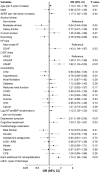Individual Trajectories of Health Status During the First Year of Discharge From Hospitalization for Heart Failure and Their Associations With Death in the Following Years
- PMID: 37421271
- PMCID: PMC10382098
- DOI: 10.1161/JAHA.122.028782
Individual Trajectories of Health Status During the First Year of Discharge From Hospitalization for Heart Failure and Their Associations With Death in the Following Years
Abstract
Background Improving health status is one of the major goals in the management of heart failure (HF). However, little is known about the long-term individual trajectories of health status in patients with acute HF after discharge. Methods and Results We enrolled 2328 patients hospitalized for HF from 51 hospitals prospectively and measured their health status via the Kansas City Cardiomyopathy Questionnaire-12 at admission and 1, 6, and 12 months after discharge, respectively. The median age of the patients included was 66 years, and 63.3% were men. Six patterns of Kansas City Cardiomyopathy Questionnaire-12 trajectories were identified by a latent class trajectory model: persistently good (34.0%), rapidly improving (35.5%), slowly improving (10.4%), moderately regressing (7.4%), severely regressing (7.5%), and persistently poor (5.3%). Advanced age, decompensated chronic HF, HF with mildly reduced ejection fraction, HF with preserved ejection fraction, depression symptoms, cognitive impairment, and each additional HF rehospitalization within 1 year of discharge were associated with unfavorable health status (moderately regressing, severely regressing, and persistently poor) (P<0.05). Compared with the pattern of persistently good, slowly improving (hazard ratio [HR], 1.50 [95% CI, 1.06-2.12]), moderately regressing (HR, 1.92 [1.43-2.58]), severely regressing (HR, 2.26 [1.54-3.31]), and persistently poor (HR, 2.34 [1.55-3.53]) were associated with increased risks of all-cause death. Conclusions One-fifth of 1-year survivors after hospitalization for HF experienced unfavorable health status trajectories and had a substantially increased risk of death during the following years. Our findings help inform the understanding of disease progression from a patient perception perspective and its relationship with long-term survival. Registration URL: https://www.clinicaltrials.gov; unique identifier: NCT02878811.
Keywords: acute heart failure; death; health status; prognosis.
Figures




Similar articles
-
Torsemide Versus Furosemide After Discharge in Patients Hospitalized With Heart Failure Across the Spectrum of Ejection Fraction: Findings From TRANSFORM-HF.Circ Heart Fail. 2024 Mar;17(3):e011246. doi: 10.1161/CIRCHEARTFAILURE.123.011246. Epub 2024 Mar 4. Circ Heart Fail. 2024. PMID: 38436075 Free PMC article. Clinical Trial.
-
Effects of Empagliflozin in Women and Men With Heart Failure and Preserved Ejection Fraction.Circulation. 2022 Oct 4;146(14):1046-1055. doi: 10.1161/CIRCULATIONAHA.122.059755. Epub 2022 Sep 13. Circulation. 2022. PMID: 36098051 Free PMC article. Clinical Trial.
-
Clinical Characteristics and Outcomes of Patients With Heart Failure With Reduced Ejection Fraction and Chronic Obstructive Pulmonary Disease: Insights From PARADIGM-HF.J Am Heart Assoc. 2021 Feb 16;10(4):e019238. doi: 10.1161/JAHA.120.019238. Epub 2021 Jan 30. J Am Heart Assoc. 2021. PMID: 33522249 Free PMC article. Clinical Trial.
-
Changes in Dyspnea Status During Hospitalization and Postdischarge Health-Related Quality of Life in Patients Hospitalized for Heart Failure: Findings From the EVEREST Trial.Circ Heart Fail. 2016 May;9(5):e002458. doi: 10.1161/CIRCHEARTFAILURE.115.002458. Circ Heart Fail. 2016. PMID: 27140204 Clinical Trial.
-
Health-Related Quality of Life and Mortality in Heart Failure: The Global Congestive Heart Failure Study of 23 000 Patients From 40 Countries.Circulation. 2021 Jun;143(22):2129-2142. doi: 10.1161/CIRCULATIONAHA.120.050850. Epub 2021 Apr 28. Circulation. 2021. PMID: 33906372
Cited by
-
Lower albumin levels are associated with 1-year mortality in older patients hospitalized for acute heart failure: THE ALBIMED-HF study.Intern Emerg Med. 2025 Apr;20(3):805-816. doi: 10.1007/s11739-025-03882-x. Epub 2025 Feb 13. Intern Emerg Med. 2025. PMID: 39948326
References
-
- James SL, Abate D, Abate KH, Abay SM, Abbafati C, Abbasi N, Abbastabar H, Abd‐Allah F, Abdela J, Abdelalim A, et al. Global, regional, and national incidence, prevalence, and years lived with disability for 354 diseases and injuries for 195 countries and territories, 1990–2017: a systematic analysis for the global burden of disease study 2017. Lancet. 2018;392:1789–1858. doi: 10.1016/S0140-6736(18)32279-7 - DOI - PMC - PubMed
-
- Johansson I, Joseph P, Balasubramanian K, McMurray JJV, Lund LH, Ezekowitz JA, Kamath D, Alhabib K, Bayes‐Genis A, Budaj A, et al. Health‐related quality of life and mortality in heart failure: the global congestive heart failure study of 23 000 patients from 40 countries. Circulation. 2021;143:2129–2142. doi: 10.1161/CIRCULATIONAHA.120.050850 - DOI - PubMed
Publication types
MeSH terms
Associated data
LinkOut - more resources
Full Text Sources
Medical
Research Materials
Miscellaneous

